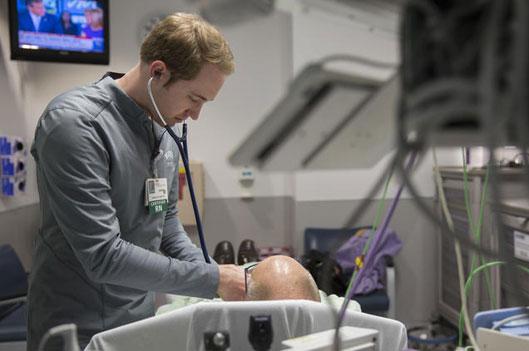An ER nurse shares the real-life drama of his work
By Lisa Jevens
The real life of an emergency room nurse might not be exactly what's depicted on TV, but there can still be plenty of drama.
Everything from birth to death comes through the door, and nurses are the ones who manage every step with hands-on care. An ER nurse never knows what to expect, yet he or she must handle everything and everyone quickly and effectively while acting as the eyes and ears of the attending physicians.
Adam Spurlock, DNP, APN, works as a charge (lead) nurse in the Emergency Department at Rush Oak Park Hospital. Spurlock knew he wanted to work in the fast-paced environment of the emergency room as soon as he had his first rotation there.
"I liked the constant turnover and change; the inability to plan your day. It just clicked," he says.
A medical traffic cop
While working in the ER for five years, Spurlock earned a Doctor of Nursing Practice (DNP) degree from the Rush University College of Nursing. This degree helped him assume a leadership role in the Emergency Department.
"I'm in charge of making sure things run smoothly in terms of staffing, communicating with other departments and helping out with overload," he says. He basically functions like a medical traffic cop, monitoring the flow of patients' progress in and out of the department. (Spurlock’s leadership training also includes earning Clinical Nurse Leader and Adult-Gerontology Acute Care Nurse Practitioner certifications.)
A typical night — Spurlock works from 7 p.m. to 7 a.m. — starts by taking over for those nurses clocking out. He takes stock of where patients are in their treatment, discharge or admission process.
As the night goes on, hospital staff gets thinner, but the ER can get busier with more acute cases. There is only one attending physician from 9 p.m. to 7 a.m., and one advance practice provider until midnight or 2 a.m., plus the nurses.
"It's usually pretty full. We are up and down — there's not too much sitting. We do get our steps in on our pedometers," Spurlock says.
The ER treats a lot of patients for abdominal pain — gastroenteritis (stomach flu), urinary infections and muscle strains are common diagnoses — heart attacks and other heart conditions, and upper respiratory complaints. In addition to managing the flow of patients, Spurlock performs everything from IV insertions to EKGs, glucose and urine tests to setting splints.
Making decisions and cleaning up messes
ER nurses have a lot of autonomy to make decisions and advise physicians, which is something most people don't realize, Spurlock says. ER nurses also must be willing to do the dirty work, from cleaning up feces and urine to putting in IVs and drawing blood, along with monitoring the patient's vital signs. In addition, they’re also the front line of communication with the patient's family.
David Manno, DO, an attending physician in the ER, says teamwork is essential in the unit, and nurses must be true team players. "It's a close work association," Manno says. "We rely on each other to observe the patient.
“Often they will see something I might have missed because I can't be with the patient the whole time. A good ER nurse will alert you to a change in the patient and know how to manage them so you can step away for a minute."
'We see people at their worst'
This capability is important, because doctors can be responsible for six to eight patients at any given time, Manno says.
"The best ERs run like a team where people play well with others," he says. "A good ER nurse must be smart, adaptable and able to handle a large amount of stress."
"We see people at their worst, and we work in an environment where nobody's happy, because nobody makes an appointment to come to the ER. A good ER nurse must have a thick skin to take the abuse that is laid on by patients sometimes."
Manno is not just speaking figuratively. Spurlock's shift often sees intoxicated patrons from nearby bars after closing time, often accompanied by police.
"They can cause a ruckus," says Spurlock, who has been assaulted by angry patients. In those situations, he follows crisis intervention procedures and attempts to de-escalate the situation —and, of course, calls security.
On the other hand, he takes pride and satisfaction being a member of an effective ER team and providing care for patients. In one especially rewarding case, emergency personnel brought in a man who had been found unresponsive in a coffee shop, most likely due to cardiac arrest. The condition is almost always fatal, but the ER was able to revive him, and eventually the patient — a new father who just had bought a house — made a full recovery.
"To see the efforts of many staff members produce such a good result was great," Spurlock says.







